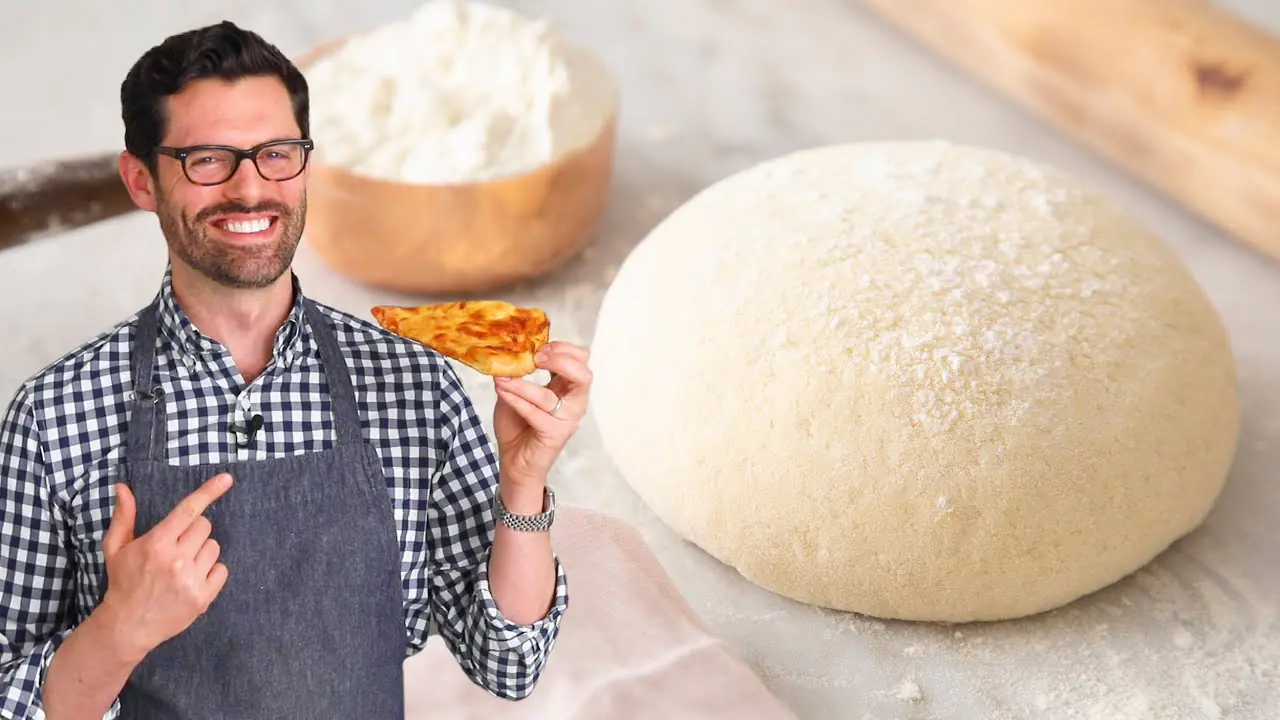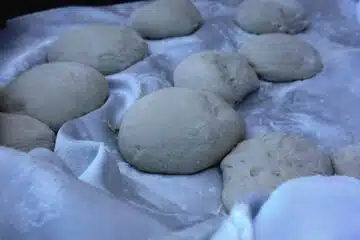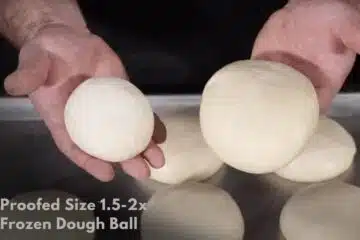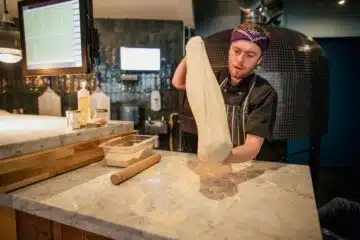Professionals make pizza dough by mixing flour, water, yeast, and salt. They knead the mixture into a smooth, elastic ball before fermentation.
Mastering the art of pizza dough is not just a skill, it’s a journey of self-discovery and culinary excellence. The satisfaction of creating an effective dough, one that forms the foundation of a great pizza, balancing crispness with chewiness, is unparalleled. Professional chefs, like you, select high-quality ingredients, ensuring the flour has the right protein content to achieve the desired texture. This pursuit of perfection is what sets you apart.
The key to creating a perfect pizza dough lies in your hands, in the precision of your measurements and techniques. The dough requires your careful handling through the mixing, kneading, and proofing stages. Temperature, too, is under your control; both the water and the environment need to be just right to activate the yeast without killing it. This process, honed by experts like you, results in pizza dough that puffs up beautifully with a flavorful crust, ready to be topped and baked to perfection.
The Essentials Of Pizza Dough
Pizza dough is both an art and a science, and you, as a professional, have the power to master it. Getting it right can elevate your pizza from good to extraordinary. For professionals like you, creating the perfect dough is about understanding and perfecting a few core elements. These essentials are critical for achieving that ideal texture and flavor in your pizza. And the best part? You have the freedom to adapt these elements to your preferences, making each pizza uniquely yours.
Selecting The Right Flour
The foundation of a remarkable pizza is the right flour. Professionals often opt for high-protein flour like bread flour or Italian 00 flour, as they are key to creating the perfect dough structure.
| Flour Type | Protein Content | Best For |
| All-Purpose Flour | 8-11% | Thin Crust |
| Bread Flour | 12-14% | Chewy Crust |
| Italian 00 Flour | 11-12% | Neapolitan Pizzas |
Importance Of Yeast Quality
Yeast is the driving force behind the rise and texture of pizza dough. Fresh or instant yeast works best. Always check the expiration date to ensure it’s active.
- Fresh yeast – Also known as ‘cake yeast.’ It should be crumbly, with a creamy hue.
- Active dry yeast – Granules should be uniform in size and color, indicating freshness.
- Instant yeast – It’s more potent than active dry yeast and doesn’t require activation.
Remember, the right yeast means a perfectly risen dough, full of flavor and with the ideal texture.
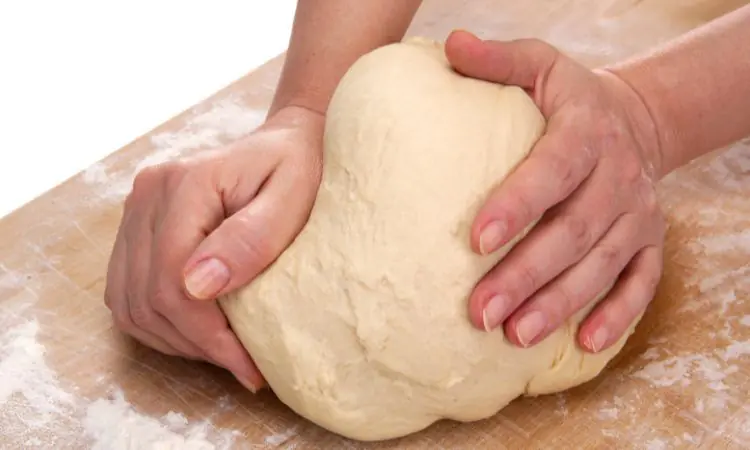
Water Temperature Matters
Imagine biting into a slice of perfect pizza. The secret lies in the dough, and it is a crucial factor for professionals.
It is the water temperature. Water temperature plays a vital role in dough consistency and quality. Let’s delve into how pros manage this element for that sublime pizza base.
Effects On Yeast Activation
Yeast is a living organism that requires a specific temperature range to start its work. Cold water slows down yeast activity, while excessively hot water can kill it. The magic happens with lukewarm water, which provides yeast with the ideal environment to produce the gases that make the dough rise.
Consider this simple breakdown:
- Below 70°F (21°C): Yeast activity decreases significantly.
- Between 75°F-95°F (24°C-35°C): Yeast thrives and ferments properly.
- Above 120°F (49°C): Yeast cells begin to die.
Finding The Perfect Balance
Not all flours are the same. Each type reacts differently to water temperature, affecting the final dough. Professional bakers measure and adjust. They use thermometers and consider kitchen temp to ensure they hit that sweet Spot.
| Flour Type | Ideal Water Temp |
| All-purpose Flour | 80°F (26°C) |
| Bread Flour | 75°F (24°C) |
| Whole Wheat Flour | 70°F (21°C) |
Exactitude matters. Use a digital scale for precision. Every degree of temperature affects taste and texture. Professional bakers adjust and monitor this throughout the process, ensuring the dough always reaches its full, delicious potential.
Salt And Sugar: More Than Just Flavor
When you think of pizza dough, you might picture flour, water, and yeast. But salt and sugar play crucial roles in pizza-making wizardry. They aren’t just for taste; they enhance the fermentation process and affect the dough’s texture. Let’s dive into the science behind these essential ingredients.
Their Role In Fermentation
Yeast needs food to produce carbon dioxide, which makes pizza dough rise. Sugar is that food. When yeast consumes sugar, fermentation begins. Salt, on the other hand, controls this process. It ensures the dough ferment slowly. With the perfect balance, the dough could be flat or over-proofed.
Impact On Dough Texture
Salt strengthens gluten, the protein web in the dough, that creates texture and chewiness. The right amount of salt gives the dough the right consistency. It shouldn’t be too sticky or too dry. Sugar, when it caramelizes, provides a golden-brown crust. It also retains moisture, so the interior stays soft.
| Quick Glance: Salt and Sugar’s Roles in Pizza Dough | ||
| Ingredient | Fermentation | Texture |
| Salt | Controls yeast’s speed | Strengthens gluten |
| Sugar | Feeds yeast | Moisture & color |
Kneading: The Heart Of The Matter
Imagine the soul-stirring aroma of fresh pizza wafting through the air. That perfect chewiness and crisp edge aren’t just happy accidents. They’re the result of meticulous kneading—the heart of pizza dough making. Let’s delve into the tactile world where professionals turn simple ingredients into culinary art.
Developing Gluten Networks
Developing gluten networks is akin to building a house’s foundation. With a strong base, the structure will stand tall. Gluten, a protein found in wheat flour, becomes the backbone of your dough once it’s activated. But how does one bring it to life? The magic begins with the mix of flour and water.
- Gluten strands start to form when water hits the flour.
- With each push and fold, these proteins link together.
- They create a matrix that gives dough strength and elasticity.
For the perfect pizza base, gluten development is key. It ensures your pizza can hold all its toppings without sagging—or worse, breaking apart.
Techniques For The Perfect Elasticity
To achieve the dreamy stretchiness in pizza dough, professionals use specific kneading techniques. Kneading does more than combine ingredients.
| Technique | Description | Benefit |
| Push and fold | Gently pushing the dough away, then folding it back over itself. | Aligns the gluten strands and builds structure. |
| Quarter turns | Rotating dough 90 degrees after every kneading. | Ensures even texture and prevents sticking. |
| Rest intervals | Short breaks during the kneading process. | It allows the dough to relax and gluten to develop naturally. |
Stretch, fold, repeat—that’s the mantra. A rhythmic dance of hands and dough that, when done correctly, leads to pizza perfection. Whether professionals use the traditional hand-kneading method or rely on a mixer with a dough hook, the aim is perfect elasticity. This gives dough the ability to rise beautifully with a well-defined crumb structure.
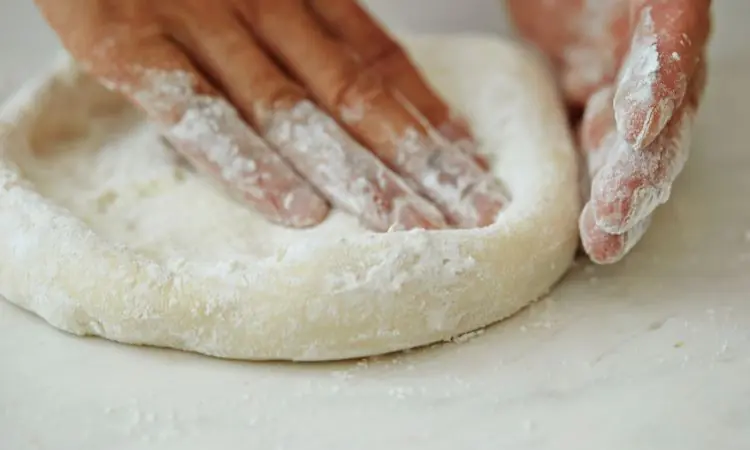
Rise And Shine: Mastering Fermentation
Creating the perfect pizza dough is an art. What is the secret behind that irresistible rise and unbeatable flavor? Fermentation. This crucial step allows yeast to transform simple ingredients into a bubbly, elastic dough that bakes up to perfection. Let’s delve into the science of dough fermentation and learn how professionals use time and temperature to achieve the golden crust and soft interior we all crave. With a few expert tips, you can master the art of fermentation and make pizza dough that rivals your favorite pizzeria.
Time And Temperature
Time and temperature dictate the pace of fermentation. The yeast comes alive in a warm environment, feasting on sugars, creating carbon dioxide, and adding volume to the dough. A professional pizzeria relies on precise settings to ensure consistent results every time. Here’s a breakdown:
- Optimal temperature: 75°F to 78°F (24°C to 26°C)
- Fermentation time: 1 to 2 hours at room temperature
- Proofing: Additional 4 to 24 hours for flavor development
This process, combined with regular stretches and folds, results in a dough that’s both full of air pockets and incredibly flavorful, ideal for a classic pizza base.
Cold Fermentation Vs. Room Temperature
Dough experts often choose between cold fermentation in a refrigerator or letting the dough rise at room temperature. Each technique impacts the flavor and texture of your pizza crust.
| Cold Fermentation | Room Temperature | |
| Duration | 24 to 72 hours | 1 to 2 hours |
| Flavor | Complex, tangy | Simple, yeasty |
| Texture | Chewy, airy | Soft, light |
For a deep flavor and better texture, professionals often opt for cold fermentation. This slows down yeast activity but allows enzymes to enhance the dough’s flavor. Room-temperature fermentation is ideal if you’re short on time but still want a delicious homemade crust.
Rolling And Shaping Like A Pro
Mastering the art of rolling and shaping pizza dough sets the foundation for a perfect crust. It’s what separates amateurs from pros. Professional chefs have a few secrets up their sleeves. These methods ensure that the dough is even and has the right texture. Let’s dive into the nuances of rolling and shaping like a pro for that impeccable pizza base.
Creating The Ideal Base
Start with well-rested dough on a lightly floured surface. Pros: Use a rolling pin to flatten the dough into a circular shape gently. Constant rotation is key. This helps create a uniform thickness. Use your fingertips to form a small rim around the edge. This gives the pizza its classic crust.
- Begin with a smooth, round ball of dough.
- Flour the surface to prevent sticking.
- Roll from the center outwards, ensuring consistent pressure.
- Rotate frequently for a round shape.
- Finish with a finger-formed rim for the crust edge.
Preventing The Dough From Tearing
To prevent tears, pros handle the dough with care. The dough should be neither too wet nor too dry. Stretch the dough by draping it over your fists. Gently pull and rotate the dough, letting gravity help with the stretch. This method ensures even thickness without tearing.
- Ensure proper dough hydration for flexibility.
- Drape over fists and stretch gently.
- Use gravity to help achieve the desired size.
- Avoid overworking to prevent snapping back.
Tips From The Masters: Seasoning And Aging
Crafting the perfect pizza dough is an art. Expert pizza chefs have long-held secrets that elevate their dough into realms of culinary excellence. Two critical factors in achieving this perfection are seasoning and aging. Let’s dive into the wisdom of pizza gurus and uncover how these elements dramatically transform the dough.
Enhancing Flavor Layers
The magic begins with seasoning. A masterly seasoned dough is the foundation of a flavorful pizza. Seasonings are more than just salt; they involve a constellation of spices and herbs that harmonize to create profound tastes.
- Fresh herbs inject an aromatic quality.
- Infused oils add a depth that captivates.
- Quality salt brings out the dough’s inherent flavors.
Here’s a table with typical seasonings:
| Seasoning | Effect |
| Oregano | Earthy, peppery notes |
| Basil | Fresh, sweet aroma |
| Garlic Powder | Bold, punchy flavor |
The Benefits Of Dough Aging
Dough aging, also known as fermentation, is a game-changer. It develops complexity and texture. Let’s explore the advantages:
- Flavor matures, becoming more nuanced.
- Texture improves, leading to a crispy crust with a chewy center.
- Digestibility increases as fermentation breaks down gluten.
Ideal aging times can vary. A minimum of 24 hours is standard, but some chefs swear by a slow 72-hour ferment. The temperature plays a vital role; a cold environment is best for a long, slow aging process that builds exquisite flavor profiles.
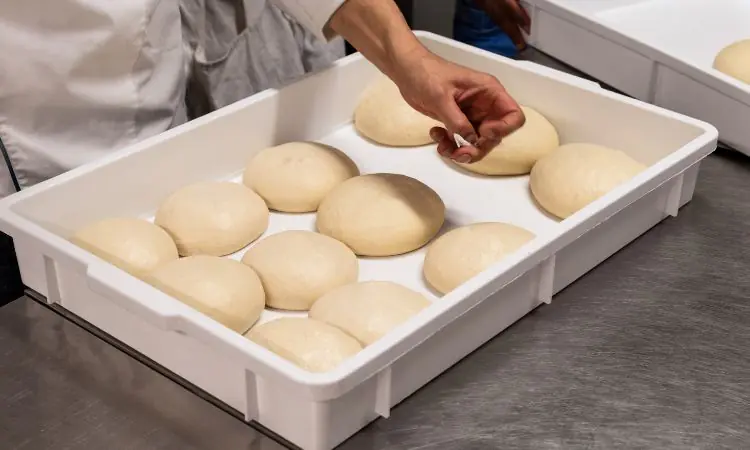
Baking Techniques For The Ultimate Crust
For pizza lovers, achieving the ultimate crust is akin to finding the Holy Grail of baking. Professional chefs know that the secret to a stellar crust lies in the baking techniques employed. The intertwining dance of heat, timing, and tools like baking stones and steels paves the path for a crust that’s both crispy and chewy. Let’s knead through the essentials that transform dough into crust perfection.
Oven Types And Temperatures
Different ovens yield different results. Brick wood-fired ovens reach up to 900°F, creating quick-baking marvels with distinct charred flavors. Convection ovens, with their circulating air, produce an evenly cooked symphony. Home gas or electric ovens, typically maxing out at 500°F, demand longer baking times but can still deliver a delightful crunch. It’s crucial to know your oven and adjust the temperature to match the desired outcome.
| Oven Type | Max Temperature | Baking Time |
| Wood-fired | 800-900°F | 1-2 minutes |
| Convection | 450-500°F | 5-7 minutes |
| Gas/Electric | Up to 500°F | 7-10 minutes |
Using Baking Stones And Steel
Baking stones and steel are professionals’ secret weapons. These tools imitate the heat distribution of commercial ovens. A preheated stone or steel ensures a rapid rise in dough temperature, forming that sought-after crispy base. Remember to preheat for at least 30 minutes to achieve that optimal sizzle on your dough.
- Baking Stones: Great for moisture absorption, giving you a crisp crust.
- Baking Steels: Superior for heat conduction and slicing bake time.
Common Mistakes To Avoid
Making pizza dough like a pro involves much more than mixing flour and water. A few common slip-ups could turn your homemade pizza dream into a kitchen nightmare. Let’s ensure you know what not to do!
Overworking The Dough
Perfect pizza dough is all about balance. Over-kneading is a pitfall many face. The dough should be soft and slightly tacky, not tough. Be gentle! Here are key indicators to watch for:
- The dough springs back slightly when poked.
- It’s smooth and has a consistent texture.
- It doesn’t tear when you stretch a small piece to make a “window.”
Stop kneading as soon as you hit these milestones. Your dough will thank you with the perfect chewiness.
Misjudging The Proofing Time
Proofing is the art of letting the dough rise. Less time can make a big difference. Follow these tips:
| Condition | Proofing Time |
| Room Temperature (70-75°F) | 1-1.5 hours |
| Colder Room (below 70°F) | Longer, up to 2-4 hours |
| Warm Spot (above 75°F) | Shorter, as little as 45 minutes |
Use these times as a guide. Your dough should double in size, not spill over the bowl, and not be hard to the touch. Adjust proofing times based on your kitchen’s conditions.
Putting It All Together: Recipe And Variations
Mastering the art of pizza dough is a skill that can elevate your homemade pizzas to a professional level. With a classic recipe and a touch of creativity, you can craft a variety of delectable doughs. Let’s explore the traditional Neapolitan dough and some innovative variations that incorporate whole grains and unique add-ins.
A Classic Neapolitan Dough
A traditional Neapolitan pizza dough starts with four simple ingredients: flour, water, yeast, and salt. The key to perfect dough lies in the quality of flour and precise measurement. The resulting dough should be soft, elastic, and full of flavor.
| Ingredient | Quantity |
| 00 Flour | 500g |
| Warm water | 325g (65% hydration) |
| Fresh yeast | 3g |
| Salt | 15g |
- Dissolve yeast in water and allow it to activate.
- Mix flour and salt, then add water/yeast mixture.
- Knead until smooth and let rise until doubled.
- Shape and bake at the highest oven temperature.
Experimenting With Whole Grains And Add-ins
For a nutritious twist, integrate whole grain flours like whole wheat, spelled, or rye. These flours add a nutty flavor and can enhance the texture. Seed and herb add-ins such as flaxseed, sesame, or rosemary bring new dimensions to your dough.
- Replace up to 50% of white flour with whole grain flour.
- Maintain hydration by adjusting the water as needed.
- Add seeds or dried herbs to the flour mix before kneading.
Whether sticking with the classics or exploring new flavors, the journey to the perfect pizza dough is both addictive and rewarding. Start with these bases and make your pizza masterpiece.
Frequently Asked Questions
What Is The Secret To Making Good Pizza Dough?
The secret to good pizza dough lies in high-quality flour, proper kneading, accurate yeast proportion, optimal water temperature, and sufficient resting time.
What Is The Secret Ingredient For Pizza?
The secret ingredient for pizza is often considered to be the passion of the chef, alongside high-quality, fresh ingredients. Perfecting the dough’s texture and flavor also plays a crucial role.
What Is The Secret To The Best Pizza?
The best pizza secrets are quality ingredients, a well-fermented dough, an optimal oven temperature, masterful topping combinations, and skilled baking techniques.
What Is The Most Important Ingredient In Pizza Dough?
The most crucial ingredient in pizza dough is flour, providing structure and elasticity.
Conclusion
Mastery of pizza dough is key to the perfect crust. Professional techniques elevate homemade pizzas. They blend tradition with precision, ensuring top-notch results every time. Remember, practice and the right ingredients make all the difference. Get kneading and join the ranks of pizza artisans.

As the author of the “Ultimate Pizza Guide: Recipes, Tips & Secrets Revealed,” I’m dedicated to sharing my love for pizza and empowering others to create delicious homemade pizzas with ease. Join me on a journey to uncover the secrets to perfecting your pizza game!
